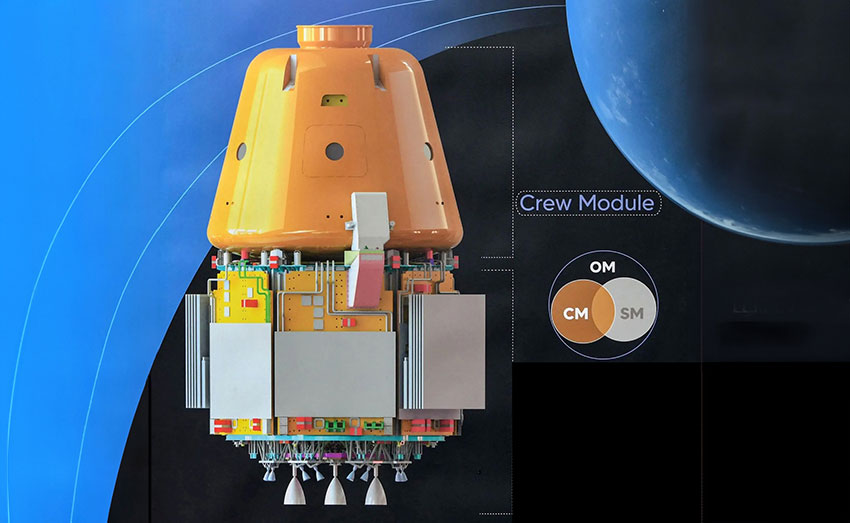
In a gripping moment at ISRO’s Bengaluru headquarters, India’s pride, the Pragyaan rover, from the Chandrayaan-3 mission approached the lunar surface. The entire nation was glued to the live stream of the landing, every Indian praying for its success, as if it was their own personal victory. Suddenly, a thunder of applause and cheers took over the control room. YES! India had done it. We had landed on the south pole of the moon, the only country to do so. Absolutely ecstatic scenes.
Now, with a legacy of numerous such space triumphs, ISRO now sets its sights on its boldest venture yet: the Indian Human Spaceflight Programme, led by its poster boy ‘The Gaganyaan.’
In 2018, PM Modi announced the Gaganyaan mission, a crucial step for ISRO’s space exploration goals. With a budget of Rs. 9023 crore, the project aims to demonstrate India’s human spaceflight capabilities by sending a three-member crew to a 400 km Low Earth Orbit for a three-day mission. The crew will conduct experiments and return safely to Earth, splashing down in the Arabian Sea, where the Indian Navy will recover them. Its success will make India only the fourth country, after the USA, Russia, and China, to achieve manned space missions.
ISRO’s flagship crewed mission, following two uncrewed missions in 2024, is set to launch in 2025 from the Satish Dhawan Space Centre in Andhra Pradesh. ISRO Chairman S Somnath emphasized the need for careful planning and safety due to human lives involved. Two unmanned robotic missions are also planned to demonstrate mission capabilities and safety standards, with any errors during the unmanned missions requiring corrections and additional tests.
Named ‘Gaganyaan,’ meaning ‘space vehicle’ in Sanskrit, the mission spacecraft comprises three key components: the Launch Vehicle (LVM3), Crew Escape System, and Orbital Module (OM). LVM3, ISRO’s most powerful launch vehicle, previously used in successful missions like Chandrayaan-2 and Chandrayaan-3, has been adapted for this mission by including a Crew Escape System for astronaut safety. The Orbital Module, an 8.2-ton capsule, will orbit Earth in Low-Earth Orbit (LEO), serving as an astronaut base similar to the ISS. It consists of the Crew Module, a 5.3-ton spacecraft for a 3-member crew, and the 2.9-ton Service Module providing essential orbit support. Together, they enable Gaganyaan to reach 400 km in LEO and safely return to Earth after its mission.
The Gaganyaan Programme aims to demonstrate India’s capability for human spaceflight to Low Earth Orbit (LEO), paving the way for a sustained human space exploration program. Its primary goal is to achieve autonomy in space access, fostering national development through industry and academia collaboration.The project also highlights the potential for space tourism, suggesting that ISRO’s successful Gaganyaan mission could attract significant revenue and global space tourists, with confidence built on ISRO’s successful launches.
The Gaganyaan mission, costing approximately Rs 10,000 cr ($1.25 billion), holds significant ROI potential, particularly in academia and R&D. With the competitive space industry, fostering indigenous technology is crucial. Anil Prakash, Director General at Satcom Industry Association (SIA) India, highlights the mission’s strategic importance, job creation, and human resource development. It advances space technology, supporting future exploration and collaboration between academia and industry. This project, with its lab and institute collaborations, also inspires and guides Indian youth toward careers in science and technology, fostering innovation and creativity.
The Gaganyaan mission embodies India’s cultural and philosophical values of “वसुधैव कुटुम्बकम्”, expanding into space technology. Dr K Sivan highlighted its symbolization of international cooperation, involving over 6 countries, such as Russia’s Gagarin Cosmonaut Training Centre, France’s CNES, Australia’s ASA, the EU’s ESA, and agencies from Canada and Romania, fostering technology exchange. ISRO also collaborates with various institutions and organizations, benefiting from their expertise, creating a mutually beneficial partnership. Key collaborators include the Indian Air Force, DRDO, maritime agencies, IMD, CSIR Labs, academic institutes like IITs, TIFR, IICT, and industry partners like HAL.
I strongly am in the favor of more such top-down collabs on the lines with the mission objective to ensure maximal industry participation of the R&D sections of the country, a right step towards integrating knowledge, innovation and fruitful application to strengthen the position of India in space market, which is in-fact the need of the hour.
For the first crewed Gaganyaan-3 mission, Indian Air Force test pilots are selected as astronaut trainees. ISRO and the Indian Air Force jointly define the selection criteria, considering flying experience, fitness, psychological evaluation, and aeromedical assessments, including BMI, skinfold thickness, and limb circumference. These trainees are currently undergoing rigorous training in Bengaluru, covering classroom instruction, physical fitness, simulator training, and flight suit preparation. In 2020, they embarked on their journey with generic space flight training in Russia’s Gagarin Cosmonaut Training Centre, returning in 2021. Their training surpasses the mission’s demands, with top instructors like Rakesh Sharma and survival expert Abhilash Tomy ensuring excellence.
This mission is a profound physical and mental challenge. Those chosen are exceptional individuals with the courage to venture into the unknown, survive it, and push the boundaries of the sky. Hats off to these brave souls! We pray for their safe journey and a remarkable experience.
ISRO’s Vyommitra, an AI-powered humanoid, will participate in unmanned test missions (Gaganyaan 1 & 2) before crewed missions (Gaganyaan 3). Resembling a human in facial expressions, it aims to communicate feedback and data during tests. Vyommitra can withstand shocks, vibrations, conducts microgravity experiments, and aids astronauts during the mission. It can speak Hindi and English, detects environmental changes, and performs tasks with human intervention.
It’s now time to announce that this New India, is a fearless one, one who has courage to work hard and BECOME THE BEST, and remember, We are the representatives of this New India!
PC: Manjunath Kiran—AFP/Getty Images

Aryan Gokul Raut
FY BTech COMP, KJSCE






Leave a Reply